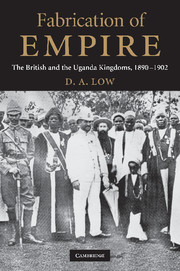Book contents
- Frontmatter
- Contents
- Preface
- List of abbreviations and locations
- Sketch maps
- 1 Prologue: survey and agenda
- 2 Statecraft: external intrusion and local dominion
- 3 Ferment: conversion and revolution in Buganda
- 4 Upcountry: might-have-beens and the Buganda/Uganda outcome
- 5 Warbands: new military formations and ground level imperialism
- 6 Paramountcy: Toro, Busoga and the new overlords
- 7 Defeat: Kabalega's resistance, Mwanga's revolt and the Sudanese mutiny
- 8 Succession: Nkore and the war of Igumira's eye
- 9 Dénouement: aggregations and rulerships
- 10 Government: colonial settlements and the Buganda model
- 11 Capstone: honour, awe and imperialism
- 12 Round up and review
- Select bibliography
- Index
2 - Statecraft: external intrusion and local dominion
Published online by Cambridge University Press: 04 July 2009
- Frontmatter
- Contents
- Preface
- List of abbreviations and locations
- Sketch maps
- 1 Prologue: survey and agenda
- 2 Statecraft: external intrusion and local dominion
- 3 Ferment: conversion and revolution in Buganda
- 4 Upcountry: might-have-beens and the Buganda/Uganda outcome
- 5 Warbands: new military formations and ground level imperialism
- 6 Paramountcy: Toro, Busoga and the new overlords
- 7 Defeat: Kabalega's resistance, Mwanga's revolt and the Sudanese mutiny
- 8 Succession: Nkore and the war of Igumira's eye
- 9 Dénouement: aggregations and rulerships
- 10 Government: colonial settlements and the Buganda model
- 11 Capstone: honour, awe and imperialism
- 12 Round up and review
- Select bibliography
- Index
Summary
A glance at an all-Africa map will soon indicate how small an area relative to the rest of the continent was occupied by the numerous rulerships in the East African interior that were encircled by the string of lakes north of Lake Tanganyika (see Map 1). Add an average climate map – semi-arid lands to the north and east, wet tropical forests to the west – and any surprise that they remained long isolated from the outer world will be much reduced.
In view of the extensive kinglists which are common throughout this region it is widely claimed that many of their rulerships have a lengthy heritage. Their roots seem to lie well back in the first millennium ad, before beginning to take shape plus and minus 1100, and then assuming some more recognisable form plus and minus 1500. It was during the latter period – the eleventh to sixteenth centuries – that the large earthworks in western Buganda at Ntusi, Bigo and thereabouts, which clearly required some considerable organised authority to construct, seem to have been built and occupied. Thereafter, it can begin to be plausibly shown that by the sixteenth century, through many vicissitudes, some important dynasties that lasted through to the late twentieth century had come into being.
- Type
- Chapter
- Information
- Fabrication of EmpireThe British and the Uganda Kingdoms, 1890–1902, pp. 28 - 56Publisher: Cambridge University PressPrint publication year: 2009



